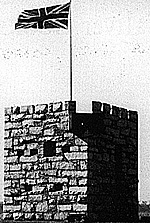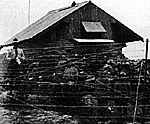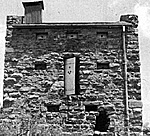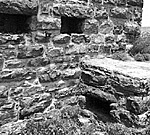The popular image of a blockhouse of the Second Anglo-Boer War (1899-1902) is that of a circular metal construction entangled by wire fortifications sitting forlornly in the middle of the veldt. Correct as this is, there were however, two other types of 'blockhouses'.
 The first blockhouses were built on the orders of the British Commander-in-Chief, Field Marshal Lord Roberts, in March 1900 following the capture of Bloemfontein. Roberts was eager to protect his army's main supply route, the railway connecting Bloemfontein to the Cape. These blockhouses were large two storey constructions of stone. At one corner on the roof was a platform for mounting a machine gun.
The entrance was through a door on the first floor, seven to eight feet off the ground, accessed by a ladder. The walls on both floors were loopholed. Each blockhouse cost between 800 pounds to 1,000 pounds and took 3 months to build.
The first blockhouses were built on the orders of the British Commander-in-Chief, Field Marshal Lord Roberts, in March 1900 following the capture of Bloemfontein. Roberts was eager to protect his army's main supply route, the railway connecting Bloemfontein to the Cape. These blockhouses were large two storey constructions of stone. At one corner on the roof was a platform for mounting a machine gun.
The entrance was through a door on the first floor, seven to eight feet off the ground, accessed by a ladder. The walls on both floors were loopholed. Each blockhouse cost between 800 pounds to 1,000 pounds and took 3 months to build.
However, they were very effective. Not one bridge where one of these blockhouses was sited and manned was blown. Nonetheless, the Boers still managed to blow up plenty of other railway features that were not guarded. In the eastern Transvaal a smaller and less elaborate blockhouse was built, again to protect the railway. This was a rectangular building made from corrugated iron. The walls were made from two layers of corrugated iron about ten inches apart, the gap filled with sand and gravel. Loopholes cut from steel and encased in wood were put into the walls.
 The first blockhouse of this type was located at Nelspruit, built by a civilian contractor from
Portuguese East Africa. Illustration 2 (at right) shows the only surviving example of
this type of blockhouse, at Barberton in the eastern Transvaal. A water tank was placed on the roof.
The first blockhouse of this type was located at Nelspruit, built by a civilian contractor from
Portuguese East Africa. Illustration 2 (at right) shows the only surviving example of
this type of blockhouse, at Barberton in the eastern Transvaal. A water tank was placed on the roof.
When the Boers took to the veldt and the guerilla phase began in late 1900 they proved eluslve and were very difficult to bring to battle. Lord Milner, the British High Commissioner at the Cape, suggested extending the blockhouses away from the railway across the veldt. The idea was to literally fence the Boers in by constructing an obstacle against which pursuing British columns could trap them. In addition, supply depots could he established away from the railway along the blockhouse line giving the pursuing columns greater range.
Cheap Blockhouses
Lord Kitchener, the new Commander-in-Chief, took this suggestion up. However. to build a large number of Roberts' two storey stone blockhouses across the veldt it would be impractical and hugely expensive. So, Kitchener asked Major S.R. Rice, 23rd Field Company, Royal Engineers, to design a cheap, easily constructed blockhouse based upon the corrugated iron type first built at Nelspruit.
 Rice's new blockhouse (at right, this one manned by South African constabulary, Northern Transvaal, late 1901) maintained the basic design and construction
principles; double skin corrugated iron loopholed walls filled with rubble.
To speed up construction and reduce costs the blockhouse was circular
not rectangular. The circular design provided good all around visibility
and the lack of corners did away with the need for wooden posts. Wood
rots and also splinters when hit by bullets or shrapnel putting the
occupants at greater risk. The door to the blockhouse was sheltered by a
another piece of corrugated iron.
Rice's new blockhouse (at right, this one manned by South African constabulary, Northern Transvaal, late 1901) maintained the basic design and construction
principles; double skin corrugated iron loopholed walls filled with rubble.
To speed up construction and reduce costs the blockhouse was circular
not rectangular. The circular design provided good all around visibility
and the lack of corners did away with the need for wooden posts. Wood
rots and also splinters when hit by bullets or shrapnel putting the
occupants at greater risk. The door to the blockhouse was sheltered by a
another piece of corrugated iron.
The blockhouse had an interior diameter of 13', a gabled roof provided standing spaee of 6'. The first blockhouse cost 44 pounds, this was redueed to just 16 pounds when produced in large numbers. A blockhouse could be erected in six hours by six trained men. This design proved successful, the only significant change in design was the introduction of a circular roof. Blockhouses with this roof were known as 'pepper pots'. The double skin blockhouse walls were generally bullet proof, but would not have withstood pom-pom or artillery shells. This was not a serious problem, during the guerilla phase many Boer columns did not have any armament heavier than their rifles. But, the Buffs stationed in the eastern Transvaal reported an attack on a blockhouse at Lydenburg with dynamite which severly wounded all the blockhouse garrison.
Protecting the blockhouse a low wall, built of stone or sandbags, was built and a trench dug. Wire entanglements were erected around the blockhouse, many strands were twisted together and anchored to the ground with stays. Often annealed wire, which is impervious to wire cutters was used. The wire obstructions were extended along to the next blockhouse usually 1,000 yards away. Bells and tin cans were hung on the wire to act as alarms. Many times trip wires were connected to a loaded rifle aimed along the wire.
Towards the end of the war flares were also used. A blockhouse line was not straight, but wavelike, so one blockhouse did not fire on its neighbour. This also provided interlocking fields of fire transforming the area around the blockhouse and along the wire into a killing zone. Many blockhouses were connected by telephone, especially those along the railway where the existing telegraph poles could be used.
The first line of circular blockhouses was built in January 1901 in the eastern Transvaal, from Kaapmuiden to Komati Poort. July and August 1901 saw a major extension of the blockhouse system across south Africa. By the end of the war in May 1902 over 8,000 blockhouses had been constructed over 3,700 miles, an average of one blockhouse every half mile. For the seventeen months from January 1901 to May 1902 blockhouses were erected at a rate of 40 a month.
The typical blockhouse garrison consisted of seven men, a junior NCO and six men. A lieutenant would have charge of three to four blockhouses, a captain ten to twelve. A battalion could occupy up to 60 blockhouses.
The blockhouse system required an enormous amount of manpower. Well over 50,000 British troops, or 50 battalions, were involved in blockhouse duty, greater than the approximately 30,000 Boers in the field during the guerilla phase. Many of the troops guarding
the lines of communication and manning blockhouses were from the militia, part time civilian soldiers. In addition up to 16,000 Africans were used to patrol the line at night.
Life in a Blockhouse
Life in the blockhouse was very dull and tedious. The routine was simple and unchanging, the possibility of Boers trying to cross the blockhouse line always present. There was little scope for amusement on the veldt. A common diversion was the erection of dummy sentries. Blockhouse sentries, especially at night, were understandably nervous and tended to shoot at any sound.
Many times animals on the veldt set off the alarms causing a sentry to start shooting. On occassions a burst of fire from one blockhouse could set off a chain reaction and neighbouring blockhouses up and down the line would join in.
The blockhouse was part of a successful strategy that eventually brought the 'bittereinder' Boers to the negotiating table. Although the Boer general, Christiaan De Wet, thought they
prolonged the war because the great expansion of tht blockhouse system in mid-1901 allowed the Boers to regroup and fight on.
This article appears in MagWeb (Magazine Web) on the Internet World Wide Web.
 The partially restored remains of a stone blockhouse (left and right) at Kliprivier Drift, near Henley-on-Klip, outside Johannesburg.
The partially restored remains of a stone blockhouse (left and right) at Kliprivier Drift, near Henley-on-Klip, outside Johannesburg.
Back to Colonial Conquest Issue 11 Table of Contents
© Copyright 1996 by Partizan Press.
Other military history articles and gaming articles are available at http://www.magweb.com